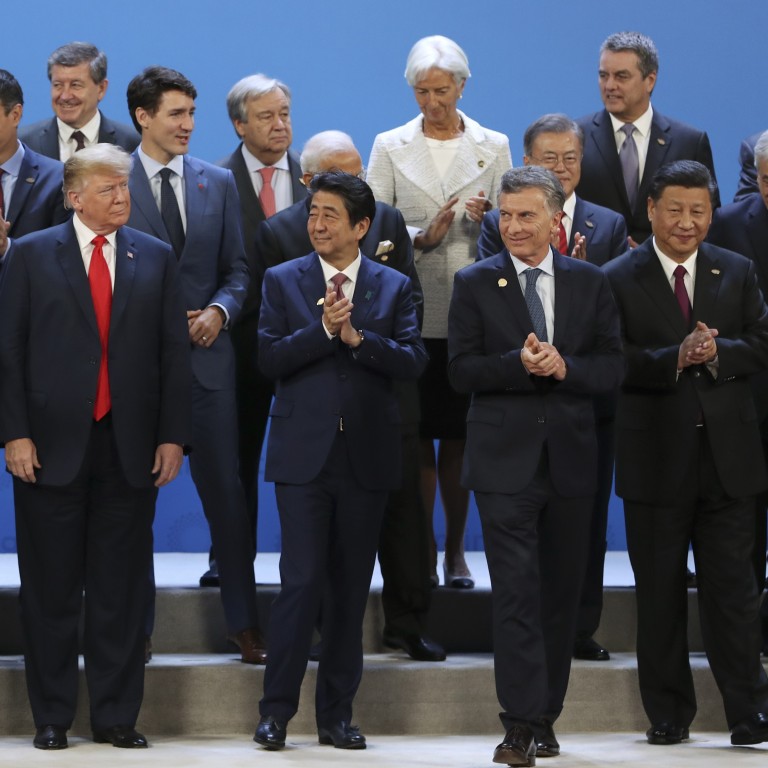
Uncertainty over US-China trade deal between Donald Trump and Xi Jinping at G20 fuels global recession fears
- It is hoped the two leaders will meet in Japan later this month to at least stop tariffs on a further US$300 billion of Chinese imports
- Global rating agency Moody’s believes there is a 45 per cent chance of a no deal scenario between the world’s two largest economies
Almost a year into the US-China trade war, Billy Wang, who runs a trading business in Shanghai, has grown increasingly resigned that the end of the dispute is nowhere in sight and will continue to chip away at his earnings.
The businessman, who supplies electronics parts like flash integrated circuits to exporters, believes it will be at least another six months before any deal will be struck between the world’s two largest economies.
“Some of our clients’ products are headed for the US, so for us, the volume of orders related to the US market has shrunk by more than half,” Wang said. “Short-term, I’m not optimistic. The fight between US and China is very intense.”
Bleak sentiments like those harboured by Wang are spreading as the fallout from the trade war penetrates deeper into global industrial value chains, clouding their growth prospects for 2019. While economists may be able to quantify the economic effects on direct trade channels, the bigger fear is the growing negative impact on global growth from a deterioration of consumer and business confidence as well as investor sentiment.
On Monday, Trump renewed his threat to impose additional tariffs on Chinese goods if there is no progress in talks with Xi, or if his Chinese counterpart refuses to meet at the G20, according to an interview with CNBC. Trump has repeatedly said he expects to meet Xi in Osaka, but Beijing has not confirmed any such meeting.
In the CNBC interview, Trump said “the China deal’s going to work out” because China was being “absolutely decimated” by companies leaving to escape the US tariffs.
Some of our clients’ products are headed for the US, so for us, the volume of orders related to the US market has shrunk by more than half
Investment bank Morgan Stanley said the re-emergence of trade tensions “snuffed out the prospects of recovery in global growth in the second half of 2019”. Projecting global growth to average 3.2 per cent for this year, economists from the bank said in a report last week that it could end up in a recession within three quarters if the US proceeds with tariffs on US$300 billion of Chinese imports, the estimated value of most of the remaining goods not yet hit by tariffs.
Only last month, stronger-than-expected first-quarter data from the European Union, the US and China, which make up nearly half of the world’s output, indicated that global growth, though still fragile, was stabilising.
But the increased US tariffs doused any short-lived optimism, although there has been a renewed wave of nationalistic rhetoric in China – from Xi and top leaders to Chinese think tanks – that the economy has the firepower and resilience to weather any external pressures and ensure long-term growth.

The trade talks collapsed because the two sides could not agree on core issues that included China halting subsidies to state-owned enterprises and reluctance by the US to lift existing tariffs before verifying enforcement of any trade deal, according to global rating agency Moody’s.
Given the impasse, the agency does not expect an agreement to be reached at the G20 summit, and has outlined three plausible scenarios: no deal but no further escalation of tensions with talks continuing into 2020; tensions being ratcheted up; and a resolution of some differences within the next month that results in a deal and removal of some existing tariffs.
Moody’s believes the first “no deal” scenario to be the most likely, assigning it a 45 per cent probability, while the second, an escalation, warranted a 40 per cent likelihood. That left only a 15 per cent chance of a near-term deal to break the trade war deadlock.
The first scenario would shave 0.1 percentage points off US growth and 0.2 percentage points off China’s growth this year through direct trade channels, Moody’s said. The economic impact of the second scenario, underpinned by the US government’s approach to taking a hard line with China as long as there is a rise in American jobs and wages, could be more than twice as severe as the first case, the agency added.
China’s business confidence gauge, which covers only the manufacturing sector, dropped by 5 per cent in May from a year earlier, compared with a 2.6 per cent decline the previous month, according to CEIC Data, which calculates the change based on the Chinese government’s monthly purchasing managers’ index.
Downbeat sentiment has not only stalled investments and business expansions in China, but also in the US and other markets because of the global, interconnected nature of modern supply chains.
In the US, investment by Chinese companies has fallen by nearly 90 per cent since its peak in 2016, according to survey by the China General Chamber of Commerce – USA conducted in February and March.
Across Asia, policymakers are bracing themselves for slower economic growth stemming from weaker global demand and escalating trade tensions, with central banks shifting towards easing policy to support their economies. Malaysia, India, the Philippines and New Zealand have all cut their interest rates this year to support growth.
China is also struggling with its slowest growth in nearly three decades, but as much as the trade war is to be blamed, its challenges lie in the need to implement more structural reforms, such as reducing state-owned enterprises’ reliance on government subsidies and raising their efficiency as a means of upgrading the industrial value chain and bolster domestic demand.
Capital Economics’ chief economist Mark Williams wrote in a report that China’s slowdown trend was inevitable, because as any emerging economy gets richer, its productivity levels approach those of developed economies.
“But China’s slowdown has been far sharper than most expected,” Williams said, attributing that to structural factors, including the country’s accelerating demographic shift – with the working age population having passed its peak and total employment declining for the first time in 50 years.
China’s labour productivity has been boosted in past decades by heavy investments. With “an unusually highly developed capital stock for an emerging economy, it means there is less need for investment in future”, Williams said.
“If demographics and investment are both going to contribute less to growth in future, the emphasis then has to be on offsetting some of that with faster growth in total factor productivity.”

That is where Beijing’s “Made in China 2025” – the industrial strategy to upgrade manufacturing and become a technology superpower – comes into play. But that strategy, and the Chinese government’s use of heavy subsidies to leap ahead of foreign competition in advanced industries, are also at the heart of the trade war.
Amid the uncertainty of whether a trade deal could be struck should Trump and Xi meet later this month, the finger pointing towards the US among Chinese policy advisers has also accelerated.
In a recent forum organised by the Beijing-backed Chinese Academy of Social Sciences think tank, vice-president Cai Fang criticised the trade war for disrupting the global order, with the continued escalation of tensions not only creating economic losses for China and the US, but also having directly hurt other developed and emerging markets.
“China doesn’t want a war, is not in love with it, nor afraid to battle one, the war to end war approach is reasonable,” Cai said.
Additional reporting by Chad Bray

